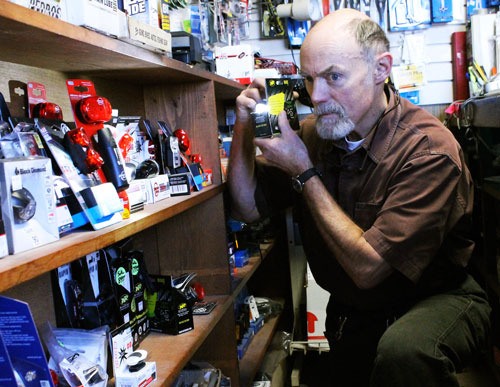After a year of serious accidents on her bicycle, Kathleen Tison became much more cautious.
Tison, who commutes to work by bike, recalls one incident in particular, where she slipped on a painted road stripe while taking a turn too fast. Her helmet wasn’t tight enough and when she hit the ground, the helmet drove her sunglasses into her face, resulting in fourteen stitches and a bill to match.
Although her accident wasn’t vehicle related, Tison practices the utmost caution when traversing through traffic.
“If you ride with the mindset that people in cars don’t see you, you’re a lot safer,” she said. “Also, if you’re polite to people in cars.”
These days Tison commutes from Roche Harbor to West Marine, where she works as store manager. In the winter months, she’s faithful to her bike riding—except when weather deems road conditions too unsafe to ride.
As the dark months of winter set in, it’s not only important for drivers to be more aware of surrounding cyclists, pedestrians and wildlife—but for cyclists to exercise increased caution as well.
“I see a lot of cyclists who wear nothing to make themselves visible to drivers. I call them ‘ninja cyclists,’” said Paul Ahart, cyclist and owner of Island Bicycles in Friday Harbor. “I’ve seen it on Roche Harbor Road. It’s the single biggest danger to cyclists.”
Washington state bicycle law requires a headlight and taillight to be used at night on your bike. Ahart has a wide range of lights for sale at his shop, with an increase in light sales during the winter. Even if you are riding on roads with street lights and don’t need a headlight to see, it’s important to be seen, he said.
From simple LED headlights that take disposable batteries or utilize rechargeable ones, to pedal-powered generators that light the road ahead, whatever you chose to spend on bicycle lighting will be less expensive then the medical bills that come after an accident.
Lighting isn’t just for the night rider. When cycling on winding roads it’s easy for cyclists to “disappear,” into the shadows cast by trees. A flashing back light gives drivers traveling around blind turns a better chance of seeing bicycles. Ahart and Tison both recommend reflective gear day and night.
Ahart suggests reflective ankle bands, which are easily seen as you pedal along.
He also stresses the importance of consistent riding. To stay over to the right (unless conditions are not safe on the shoulder, then it’s legal to ride closer to or in the middle of the road), and not weave in and out of traffic.
It’s also important to know your limits.
Although Tison has studded tires for her mountain bike in case the weather becomes too raucous, she rarely uses them. Opting to drive to work when the weather is too inclement is something both her and Ahart practice.
Well, accept for the one time Ahart went out in a snowstorm.
He thought conditions were okay after a snowstorm, and went out on his mountain bike with snow tires. Not long after his departure he fishtailed and went down into the road. Luckily the car behind him was going slow because of conditions and saw his tires begin to fishtail before he went down, so no serious injuries occurred. Ahart doesn’t credit his back flashing light for getting the driver’s attention—but he was using one.
As cyclists, neither Ahart of Tison put their bike away for the winter, rather they adopt watchful winter riding.
“Unfortunately for a lot of people you have to learn the hard way,” Tison said. “But let’s face it, road rash sucks.”



